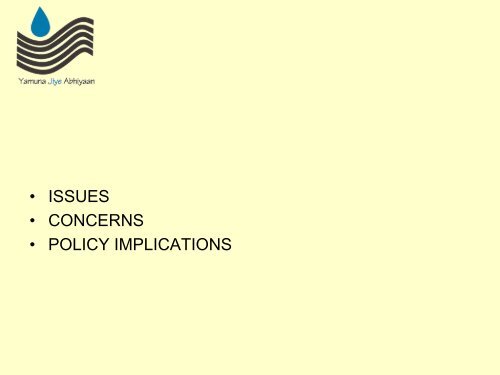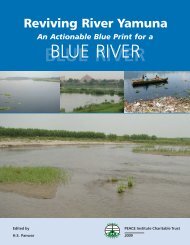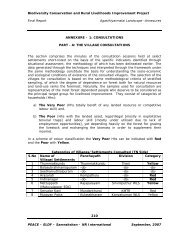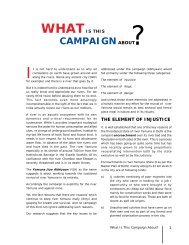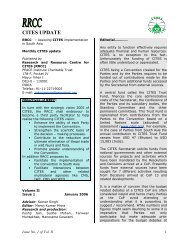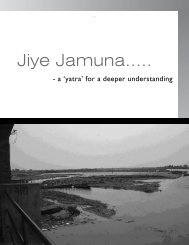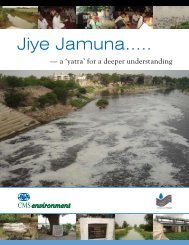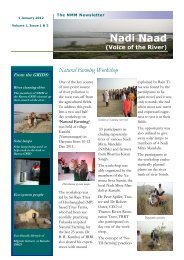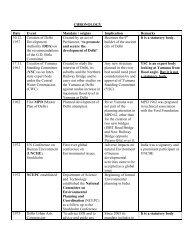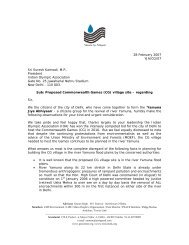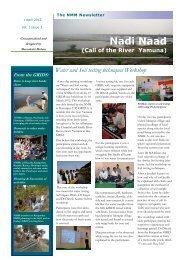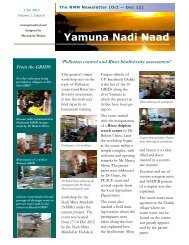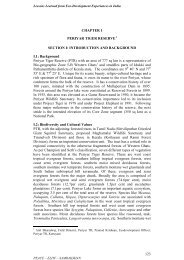Yamuna Jiye Abhiyaan - 3.12.2007.pdf - PEACE Institute Charitable ...
Yamuna Jiye Abhiyaan - 3.12.2007.pdf - PEACE Institute Charitable ...
Yamuna Jiye Abhiyaan - 3.12.2007.pdf - PEACE Institute Charitable ...
Create successful ePaper yourself
Turn your PDF publications into a flip-book with our unique Google optimized e-Paper software.
• ISSUES<br />
• CONCERNS<br />
• POLICY IMPLICATIONS
ISSUES<br />
Water and Water Security<br />
Rivers and our tendency to take them for granted<br />
Rivers flood plains as valuable ‘wetlands’ and not wastelands<br />
Judicial pronouncements and executive action<br />
Expert studies<br />
All facts in this presentation are sourced from either a published source or<br />
response/s received under the RTI Act
A river is more than a water way<br />
• It is a unique and dynamic ‘aquatic ecosystem’ and is<br />
composed of river channel that meanders and its flood plains<br />
• It moderates the impact of floods<br />
• It recharges the Ground Water<br />
• It regulates the thermal currents<br />
• It is habitat to innumerable forms of flora and fauna many of<br />
which are endangered or threatened<br />
• It is a cultural and religious symbol
Let us not compare Apple with Oranges<br />
Average Monthly Rainfall (1970 – 2000)<br />
(Source: WMO)<br />
New Delhi (<strong>Yamuna</strong>)<br />
Oxford (Thames) Paris (Seine) Vienna (Danube)<br />
Month<br />
Mean<br />
Total<br />
Rainf<br />
all<br />
(mm)<br />
Mean<br />
Number of<br />
Rain Days<br />
Mean Total<br />
Rainfall<br />
(mm)<br />
Mean<br />
Number of<br />
Rain Days<br />
Mean<br />
Total<br />
Rainfall<br />
(mm)<br />
Mean Number<br />
of Rain Days<br />
Mean Total<br />
Rainfall (mm)<br />
Mean<br />
Number<br />
of Rain<br />
Days<br />
Jan 20.3 1.7 57.5 11.5 53.7 10.2 37.2 7.3<br />
Feb 15.0 1.3 42.6 9.2 43.7 9.3 39.4 7.6<br />
Mar 15.8 1.2 50.0 10.5 48.5 10.4 46.1 8.3<br />
Apr 6.7 0.9 46.2 8.7 53.0 9.4 51.7 7.5<br />
May 17.5 1.4 53.9 9.1 65.0 10.3 61.8 8.5<br />
Jun 54.9 3.6 54.5 8.7 54.6 8.6 70.2 9.1<br />
Jul 231.5 10.0 38.2 6.7 63.1 8.0 68.2 9.0<br />
Aug 258.7 11.3 54.4 7.8 43.0 6.9 57.8 8.0<br />
Sep 127.8 5.4 58.9 9.1 54.7 8.5 53.5 7.0<br />
Oct 36.3 1.6 61.8 10.6 59.7 9.5 40.0 6.0<br />
Nov 5.0 0.1 59.4 10.1 51.9 9.7 50.0 8.3<br />
Dec 7.8 0.6 64.7 10.9 58.7 10.7 44.4 8.2<br />
Total 797.3<br />
642.1 649.6 620.3
Delhi a<br />
Helpless<br />
Island<br />
RIVER<br />
YAMUNA<br />
No tributary worth<br />
the name in plains<br />
Forms an Interstate<br />
border over<br />
large length<br />
Every state wants<br />
a pie but takes<br />
little responsibility<br />
Naturally<br />
Delhi<br />
Must plan<br />
For becoming<br />
Self dependent<br />
For water<br />
To the extent<br />
Possible<br />
Every expert<br />
report hence<br />
advices<br />
that ‘remaining’<br />
river bed in Delhi<br />
be treated<br />
sacrosanct
<strong>Yamuna</strong> at Hathnikund 17 Feb 07<br />
WYC<br />
EYC
Y<br />
a<br />
m<br />
u<br />
n<br />
a<br />
in<br />
D<br />
el<br />
hi
22 km<br />
Of<br />
River<br />
In<br />
Urban<br />
Delhi
HARD FACTS<br />
1. The 22 km stretch of river in Delhi is perhaps the most threatened<br />
riverine stretch anywhere in the world (P.Kumar, IEG, Delhi)<br />
2. It is the most polluted river stretch in the whole country today<br />
(CPCB)<br />
3. The river bed is so badly silted up and encroached upon that you do<br />
not need 1978 level flood waters to suffer the same or worst<br />
devastation in the city any more. (Less will do). (NEERI, 2005)
HARD FACTS<br />
Delhi is flood prone (1977,1978, 1988, 1995, 200..) – Needs inviolate Flood<br />
Plains<br />
Delhi is water scarce – Desperately requires ground water (more than 50% of<br />
city’s needs) and hence needs inviolate flood plains for annual monsoonal<br />
recharge of ground water<br />
Delhi sits over an Earthquake fault line (Zone IV) – River bed in Delhi<br />
is most vulnerable (According to Iyengar 2000, in a 50 yr window 1983 – 2033,<br />
Delhi would experience PGA = .2 g ) – 893 ; 1505 ; 1720 ; 1803 ; 1842 ;<br />
1905; 1956; 1960; 1966; 1991; 2001; 2005.<br />
18.10.2007 - Mild tremor felt in Delhi<br />
New Delhi, Oct 18 - A mild quake measuring 3.6 on the Richter Scale was felt in the national capital<br />
region at around 11.25 a.m. Thursday. There were no reports of casualties. Epicentre of the quake<br />
was NOIDA. (http://www.earthtimes.org/articles/show/126422.html<br />
26.11.2007- Quake of 4.6 on richter scale jolts NCR in the morning. Epicentre was Bahadurgarh.
Sub Zone 05: ITO – New Rly Bridge
Sub Zone 06: New Rly Bridge – NH 24
JJ removed and concretised as parking space
General Guidelines by NEERI, 2005<br />
(Sponsored by the DDA)<br />
(page 3.33)<br />
Through the results obtained from ground level survey and Hydrodynamic<br />
simulations, it has been established that<br />
a)The stretch has substantially lost its carrying capacity due to long term<br />
silting<br />
b)The present width of the river is desirable to maintain for conveying<br />
maximum flow of 12,750 cumecs to avoid flooding of adjoining flood plains<br />
No residential or industrial facilities requiring permanent structures should be<br />
provided on the river bed
World Bank / MOEF / IGIDR Study<br />
Valuation of Ecological Functions and Benefits: A case study of<br />
Wetland Ecosystems along the <strong>Yamuna</strong> River corridors<br />
of Delhi Region (DU and <strong>Institute</strong> of Economic Growth, Delhi, 2000)<br />
Conclusions:<br />
a) Floodplains play a crucial role in ground water recharge to the sandy aquifers<br />
present in the study area and connected aquifers in Delhi city. The importance<br />
of the water recharge function of the wetlands is amply reflected in the economic<br />
value, which is the highest among all the economic estimates of all ecological<br />
functions that were assessed.<br />
b) Channelisation of river <strong>Yamuna</strong> in the Delhi stretch will have detrimental effect<br />
on the ground water recharge which occurs through the flood plains.<br />
c) Even though, wetlands in the <strong>Yamuna</strong> river corridor are perturbed ecosystems they<br />
support a wide variety of flora and fauna as 155 plant species of 27 families and 97<br />
birds species (56% are migratory) have been documented from this area.<br />
d) Wetlands ecosystems in the <strong>Yamuna</strong> river corridor are under continuous threat for<br />
conversion to alternate uses due to the pressures of a fast expanding city.<br />
e) Benefit-cost Analysis favourably suggests the conservation of flood plain area.
World Bank / MOEF/ IGIDR study<br />
(2000)<br />
Recommendations<br />
1. A significant proportion of investment should be in physical and ecological<br />
interventions so as to maintain and conserve the ecological and hydrological<br />
character of the wetlands, which at present is under stress due to rapidly<br />
increasing anthropogenic pressures.<br />
2. As it appears from the present investigation, the hydrological functions comprise<br />
of 39.35% of the total economic value. Hence to maintain the ground water<br />
recharge potential of the floodplains, it is imperative to prevent any fresh<br />
civic structure to come up in these areas. This is necessary because fresh<br />
ground water resources present in the flood plain and connected aquifers<br />
in the city are replenished annually due to flood plains.<br />
3. Channelisation of the river in the Delhi stretch should not be carried out.<br />
Channelisation will not only lead to reduction of the ground water reserve, it will<br />
completely stop the ground water recharge that occurs from the flood plains. In<br />
the light of acute scarcity of fresh water in Delhi, reduction of the ground<br />
water reserve will further aggravate the water problem.
‘Truth’ about Global Sporting Events like<br />
Olympics, Asiad, CGW etc<br />
Article 5 – Commonwealth Games Federation (CGF) Constitution<br />
‘The Commonwealth Games are contests between athletes and not contests<br />
between countries’.<br />
These short duration (CGW 2010 is 10 day event) mega events are actually non<br />
government events (IOA is the host) which are often with few exceptions (like the<br />
Cricket World Cup organised by BCCI) facilitated specially in developing countries<br />
by respective Governments through generous use of public funds invested<br />
mostly in infrastructural constructions.<br />
Since public money is involved it is important that the kind of ‘legacy’ that such<br />
events leave behind in the host city as well as the country concerned is a matter of<br />
public concern, debate and scrutiny.
Excerpts from CG 2010 Evaluation Commission 2003 report<br />
(What was presented to the Voting members of CGF)<br />
3.4.2 Village<br />
1. The Government is constructing the Village on a pleasant and high<br />
quality site.<br />
2. Delhi has guaranteed that the Games Village will be constructed well in<br />
advance of the Games although no specific development schedule has been<br />
provided (Village construction timetable is anticipated to be 2 years).<br />
3. Post games the Village will become University accommodation.<br />
4. The Village will feature low to medium rise buildings.<br />
5. The proximity of the Village to the airport, city and the venues is excellent<br />
and will allow all athletes to live in one Village.<br />
IS ANY OF THE ABOVE TRUE ?
Unrealistic Hype and Extravaganza<br />
Tourism<br />
Asiad 82 – Against thousands of foreign tourists only 200 arrived<br />
CG 2006 (Melbourne) – Only 56000 foreign tourists visited<br />
CG 2010 – 10 lakhs foreign tourists and 40 lakhs in-country tourists projected<br />
Expenditure vs Revenue<br />
Initial Estimate of Expenditure – INR 1700 crores<br />
Current Estimate of Expenditure – INR 28000 crores<br />
Current Estimated of Revenue – INR 4550 crores
Shall we host our guests in a risky, dangerous<br />
and disturbed site?<br />
Crafting a disaster (Cherian, 2004)<br />
The CWG village site lies within the 25-year floodplain belt of river <strong>Yamuna</strong>.<br />
The rectangular land parcel lies to the west of the first girdle of East Delhi’s<br />
development, and thus closer to the River than any previous construction in its<br />
floodplain.<br />
The site is bound on all four sides by earth embankments, and lies more than six<br />
meters below adjacent roads and four meters below the infamous 1978 flood’s<br />
water level.<br />
The Kolkata branch railway line, NOIDA city link road and flood control dykes<br />
restrict drainage possibilities and limit drainage solutions to expensive mechanical<br />
dewatering. River floods, water-logging and the high ground water table<br />
create a perennial menace to any development, with high risks of structural<br />
damage and inflated construction costs.
The CWG Village sits over an unstable base of deep sediment layer. The first<br />
relatively stable layer of consolidated clay begins at 40 meters BGL, and bedrock<br />
begins at depths around 100 meters BGL.<br />
The site invariably lies in the most seismically vulnerable part with the highest<br />
peak ground acceleration expected in the city.<br />
The high water table and poor drainage further this perilous condition. Damage may<br />
intensify as a result of liquefaction, or flow of water-saturated sand or silt. Liquefied<br />
soil may flow like a mudslide towards the <strong>Yamuna</strong> river sinking or uprooting<br />
all structures in its path.<br />
The site thus is prone to tremendous damage from even mild tremors that may<br />
disturb the progressively abused and precarious geo-hydraulic balance.”
Fundamental Duty of the state (Article 48A)<br />
The State shall endeavour to protect and improve<br />
the environment and to safeguard the forests and<br />
wild life of the country.<br />
The Supreme Court observed (In the well known Span<br />
Motels Case (MC Mehta vs Kamal Nath and others, 1997) :<br />
The state as a trustee is under a legal duty to protect the<br />
natural resources.<br />
In the absence of any legislation (Rivers fall in this category), the<br />
executive acting under the doctrine of public trust cannot<br />
abdicate the natural resources and convert them into<br />
private ownership or for commercial use.
High Court of Delhi<br />
Observations of the Hon. HC, Delhi in the case WP (Civil ) No. 2112 /<br />
2002 and WP ( C ) No. 689 / 2004 dated 08.12.2005<br />
River <strong>Yamuna</strong> is lifeline for the citizens of Delhi right from its entry into<br />
Delhi till it leaves Delhi. The purity, sanctity and the cleanliness of its<br />
water has to be maintained. It is repeatedly claimed that the<br />
Government is doing its best and has already spent thousands of<br />
crores of rupees in the name of ‘Cleanse <strong>Yamuna</strong>’ Project.<br />
But the common man does not find any visible change. Encroachments<br />
on river beds and embankment have become order of the day. No<br />
effective steps have been taken to make <strong>Yamuna</strong> free from<br />
encroachments and pollution of all kinds.
Usha Mehra Committee<br />
It is because of this realization that we have entrusted the task to the<br />
Committee headed by Justice Usha Mehra (Retired). (VC-DDA; C-<br />
MCD; CP-DELHI)<br />
We direct the Committee to take up in right earnestness and day-today<br />
basis the task of removing encroachments up to 300 meters<br />
from both sides of River <strong>Yamuna</strong> in the first instance.<br />
No encroachment either in the form of jhuggi jhopri clusters or in<br />
any other manner by any person or organisation shall be permitted.<br />
<strong>Yamuna</strong> has to be re-developed in such a manner that it becomes the<br />
habitat for trees, forests and center for recreation.<br />
We are making it clear that no structure whether it pertains to<br />
religious, residential or commercial or any other purpose shall be<br />
allowed to exist.
Consider the facts:<br />
WHAT IS THE STATE CLAIMING ?<br />
We have all the approvals !<br />
1)<strong>Yamuna</strong> Standing Committee (CWC)<br />
2) Central Ground Water Authority (CGWA)<br />
3) Usha Mehra Committee of Delhi HC<br />
4) Ministry Of Environment and Forests (MOEF)<br />
5) Delhi Urban Arts Commission (DUAC)<br />
Recommendations of the NEERI report (2005)
MOEF<br />
RTI response received from MOEF informs<br />
a) IOA won the bid in Nov 2003. It approached MOEF for EC in October 2006<br />
b) MOEF issued 4 Clearance letters (14.12.06; 22.1.07; 29.3.07 and 2.4.07)<br />
c) Expert Appraisal Committee (EAC) expressed serious environmental<br />
concerns on the site and recommended change of site on 3.11.2006<br />
d) First Clearance letter (EC) provided for raising only temporary ‘dismantable’<br />
structures so that river bed could be restored to the river<br />
e) DDA served ultimatums on MOEF on three occasions 16 Jan 07, 7 March 07<br />
and 2 April 07.<br />
f) If Akshardham could be built then why not Games Village, said DDA.<br />
g) MOEF found serious shortcomings in the CWPRS report of Feb 2007<br />
h) 2 nd and 3 rd clearance letters on 22 Jan and 29 March 07 provided for DDA to<br />
plan for permanent or temporary structures subject to…..<br />
i) 4 th clearance letter on 2 April 07 provided for DDA to construct permanent or<br />
temporary structures subject to……<br />
Clearly the DDA ‘extracted’ the clearance from MOEF not on merit but<br />
persuasions and ultimatums (Mockery of EIA process at MOEF)
PONDERABLE<br />
Clearly a dangerous and wrong act is happening in the<br />
RIVER BED in the city which would further compromise the<br />
ability of the river to recharge ground water and become yet<br />
another precedence for further concretisation of the river<br />
bed.<br />
Should Delhi Metro be permitted to build ‘polluting’ ,<br />
‘residential’ and ‘commercial’ structures in the river bed<br />
against High Court orders<br />
Safer alternatives exist for the games village site in the city.<br />
There are still three years to go to the Games in Oct 2010.
SAFDARJUNG AIRPORT
DWARKA SECTOR 20
JASOLA SPORTS COMPLEX
POLICY IMPERATIVES<br />
RIVERS IN INDIA<br />
No policy (a new draft policy has dangerous portents)<br />
No legal protection<br />
River Regulation Zone (RRZ) draft with MOEF since 2002
POLICY IMPERATIVES<br />
Transparency and Accountability of the State machinery<br />
Process to decide state funding of non government events and how and to what<br />
extent and with what safeguards should the state fund such events?<br />
Process to monitor and document fast forwarding of ‘developmental’ efforts so<br />
as to avoid misuse, mis planning, disregarding of regulatory processes and mis<br />
selling of an event using unrealistic hype?<br />
Process to involve civil society in key decisions that impact the latter like how<br />
should the river be ‘developed’ if at all?<br />
How to ensure that the state itself does not become predatory in nature?<br />
CAN A ‘PUBLIC WRONG’ EVER BE TIME BARRED FOR ACTION
CITIZENS’ VISION FOR THE RIVER BED AND<br />
FLOOD PLAINS<br />
a) River bed is a wet land and belongs only to the river<br />
b) River bed cum Flood plains are city’s most valuable<br />
natural resource and meant ONLY for passage of flood<br />
waters and ground water recharge<br />
• 25 year flood line in river bed be declared sacrosanct (bridle paths<br />
and bathing ghats alone be permitted)<br />
• Flood plains beyond (between the two embankments) be used only<br />
for organically grown vegetable, fruits and flowers to meet the city’s<br />
growing requirements<br />
• River in Delhi be cleaned and turned into a functioning buffer of<br />
welcome greens and water and a model for rest of the world
Shastri Park Metro Station
Proposed CG 2010 village
• picture<br />
<strong>Yamuna</strong> Metro Depot


